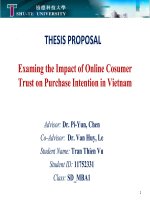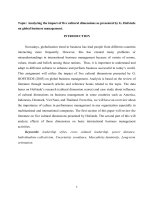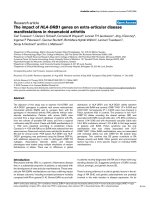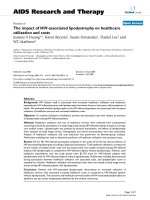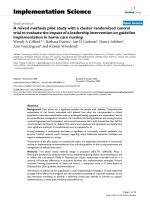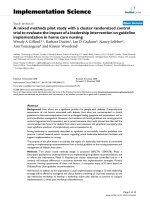The impact of collaborative vocabulary activities on efl high school students’ reading comprehension and vocabulary development
Bạn đang xem bản rút gọn của tài liệu. Xem và tải ngay bản đầy đủ của tài liệu tại đây (1.22 MB, 112 trang )
MINISTRY OF EDUCATION AND TRAINING
VINH UNIVERSITY
------------------
LE THI HA GIANG
THE IMPACT OF COLLABORATIVE VOCABULARY
ACTIVITIES ON EFL HIGH SCHOOL STUDENTS’
READING COMPREHENSION AND VOCABULARY
DEVELOPMENT
MASTER THESIS IN EDUCATON
NGHE AN, 2018
MINISTRY OF EDUCATION AND TRAINING
VINH UNIVERSITY
---------------
LE THI HA GIANG
THE IMPACT OF COLLABORATIVE VOCABULARY
ACTIVITIES ON EFL HIGH SCHOOL STUDENTS’
READING COMPREHENSION AND VOCABULARY
DEVELOPMENT
FIELD: THEORY AND METHODS OF TEACHING ENGLISH
Code: 8 140111
MASTER THESIS IN EDUCATON
Supervisor: Dr. Tran Thi Ngoc Yen
NGHE AN, 2018
ABSTRACT
The purpose of this study was to investigate the impact of collaborative
vocabulary activities on EFL high school students’ reading comprehension and
vocabulary improvement. The research was carried out at Le Thuy Technical High
School in Quang Binh with 70 eleventh grade students divided into two groups. For
experimental group, the researcher used collaborative vocabulary activities. In
contrast, for control group the researcher applied other types of activities. Data for
the research were collected from the instruments. The results revealed that using
collaborative vocabulary activities can increase students’ reading comprehension
and vocabulary improvement. It is therefore recommended that teachers use
collaborative vocabulary activities in teaching for the sake of student’s reading
ability development and vocabulary learning.
i
ACKOWLEDGEMENTS
The study would not have been completed without the invaluable assistances
and encouragements of many people for whom I am grated.
First and foremost, I would like to send my deepest gratitude to my
supervisor - Dr. Tran Thi Ngoc Yen for her valuable guidance, warm
encouragement, keen correction, helpful suggestions, careful and detailed comments
from the preparation to the completion of this study.
Second, my thanks are due to the lecturers and the staff of the Faculty of
Post- Graduate Studies at Vinh University for their useful lectures, careful guidance
and enthusiasm, which fostered nurtured my love of learning and doing research.
Next, I take this opportunity to thank all teachers of English and students at
Le Thuy Technical High School, who assisted, encouraged and participated in this
study.
Last but not least, I wish to acknowledge my family members and my
friends, who have always supported me with love and sympathy to carry out this
thesis.
Although the study has been done with all my attempts, my limitations of
ability and knowledge may cause mistakes in the thesis. Hence, all comments and
remarks on the thesis be highly appreciated.
ii
TABLE OF CONTENTS
ABSTRACT ................................................................................................................ i
ACKNOWLEDGEMENT ......................................................................................... ii
LIST OF TABLES .................................................................................................... vi
LIST OF CHARTS .................................................................................................. vii
CHAPTER 1. INTRODUCTION ...............................................................................1
1.1. Rationale ..............................................................................................................1
1.2. The aim of the study .............................................................................................2
1.3. Research questions ...............................................................................................2
1.4. Scope of the study ................................................................................................2
1.5. Thesis organization ..............................................................................................2
CHAPTER 2. LITERATURE REVIEW ....................................................................4
2.1.The reading process...............................................................................................4
2.1.1. Definition ..........................................................................................................4
2.1.2. Nature of reading...............................................................................................5
2.1.3. Reading in foreign language .............................................................................6
2.2. Reading comprehension .......................................................................................7
2.3. Assessing reading ability......................................................................................9
2.3.1. Indicators of reading ability ..............................................................................9
2.3.2. Methods to assess reading ability....................................................................10
2.4. Teaching the reading skill ..................................................................................12
2.4.1. Factors affecting EFL learners’ reading ability ..............................................12
2.4.2. Difficulties EFL learners have when learning reading ...................................17
2.4.3. Principles for teaching EFL reading ...............................................................18
2.4.4. Techniques for teaching EFL reading .............................................................21
2.5. Vocabulary .........................................................................................................24
2.5.1. Definition ........................................................................................................24
2.5.2. Word aspects ...................................................................................................25
2.5.3. The role of vocabulary ....................................................................................27
iii
2.5.4. Factors affecting vocabulary acquisition ........................................................28
2.5.5. Assessing EFL learners’ vocabulary level ......................................................29
2.6. Collaborative vocabulary activities ....................................................................31
2.6.1. Definition ........................................................................................................31
2.6.2. The benefits of collaborative vocabulary activities ........................................32
CHAPTER 3. METHODOLOGY ............................................................................35
3.1. Research questions .............................................................................................35
3.2. Participants .........................................................................................................35
3.3. Materials .............................................................................................................36
3.4. Procedures ..........................................................................................................38
CHAPTER 4. FINDINGS AND DISCUSSION.......................................................41
4.1. Results ................................................................................................................41
4.1.1.General results ..................................................................................................41
4.1.2. Pre-test and post-test reading comprehension results .....................................42
4.1.3. Pre-treatment and post-treatment vocabulary test results ..............................50
4.2. Discussion ..........................................................................................................58
4.2.1.The impact of collaborative vocabulary activities on EFL learner's reading
comprehension ..........................................................................................................58
4.2.2. The impact of collaborative vocabulary activities on EFL learner's vocabulary
development ..............................................................................................................58
CHAPTER 5. CONCLUSION ..................................................................................60
5.1. Summary of findings ..........................................................................................60
5.2. Implications ........................................................................................................60
5.3. Limitations and implications for further research .............................................61
REFERENCES ..........................................................................................................63
APPENDIX A ...........................................................................................................70
APPENDIX B ...........................................................................................................74
APPENDIX C ...........................................................................................................78
APPENDIX D ...........................................................................................................81
iv
APPENDIX E............................................................................................................85
APPENDIX F ............................................................................................................88
APPENDIX G ...........................................................................................................90
APPENDIX H ...........................................................................................................92
APPENDIX I .............................................................................................................94
APPENDIX J ............................................................................................................96
APPENDIX K ...........................................................................................................98
APPENDIX L..........................................................................................................100
APPENDIX M ........................................................................................................102
v
LIST OF TABLES
Table 4.1The general test scores of two groups
Table 4.2 Means and standard deviations of comprehension levels of both groups in
pre-test.
Table 4.3 Means and standard deviations of comprehension levels of both groups in
post-test.
Table 4.4 Frequent distribution of post-test scores of two groups
Table 4.5 Initial comprehension levels (Pre) and final comprehension levels (Post)
for all participants (P)
Table 4.6 Means and standard deviations of comprehension levels in the pre-test
and post-test for both groups
Table 4.7 Means and standard deviations of word meaning memorisation of two
groups.
Table 4.8 Word meaning scores of the Post-treatment
Table 4.9 Word spelling scores of the Post-treatment
Table 4.10 Means and standard deviations of word spelling memorisation of two
groups.
vi
LIST OF CHARTS
Chart 4.1 The Group A general test results
Chart 4.2 The Group B general test results
Chart 4.3 Results of scores on Pre- test on reading comprehension by participants
from two groups
Chart 4.4 Pre-test’s results of Group A
Chart 4.5 Pre-test’s results of Group B
Chart 4.6 Results of scores on Post- test on reading comprehension by participants
from two groups
Chart 4.7 Post- test’s results of Group A
Chart 4.8 Post- test’s results of Group B
Chart 4.9 Frequent distribution of post-test scores of two groups
Chart 4.10 Word meaning’s results of Group A
Chart 4.11 Word meaning’s results of Group B
Chart 4.12 Results of scores on Post- treatment on word spelling by participants
from two groups
Chart 4.13 Word spelling’s results of Group A
Chart 4.14 Word spelling’s results of Group B
vii
CHAPTER 1
INTRODUCTION
1.1. Rationale
Reading is one of the important skills that must be mastered by the students
both in school and in life. By doing it, the teacher can know whether the students
comprehend and understand the text or not. Therefore, the ability to read a
comprehend text efficiently is crucial for students especially for English foreign
learners. In addition, because of the demanding expectation for academic success in
all areas of learning, high school students as English foreign learners need to
develop their English reading comprehension (Ahmadi, 2012, p. 2053). That is the
reason why teaching reading is an important part of teacher’s job.
Like most students learning English as a foreign language (EFL) in
Vietnamese high schools, the students in Le Thuy Technical High School share
some common characteristics. First, they have studied English for seven years but
their ability to use English in real communication is rather limited. In fact, a lot of
English students revealed that when reading authentic texts they usually encounter
many discouraging difficulties which, more often than not, greatly hinder their
reading comprehension. Students usually do not comprehend the reading passage
because they are in the shortage of vocabulary. Second, students are fed up with the
traditional and old-fashioned teaching methods. They need a new method which can
motivate them to learn reading and vocabulary. In the recent years, efforts have
been made so that English teaching in our country can be changed from traditional
grammar- translation to the communicative language teaching (CLT). In English
classroom, CLT often takes the form of collaboration requiring the negotiation and
cooperation between learners. In addition, there are also different activities to help
them get their own courage in developing their confidence. For CLT, collaborative
activity is an important element to promote its method. On the other hand,
collaborative activity is a significant performance of effective communicative
teaching and learning. Collaborative activity stimulates the students’ involvement in
1
the classroom. It also fuels students’ motivation and helps them see the relevance of
lesson’ topics.
This study was set out to investigate the impact of collaborative vocabulary
activities on EFL high school student’s reading comprehension and vocabulary
improvement.
1.2. The aim of the study
This paper aimed to explore the impact of the collaborative vocabulary
activities on EFL high school students’ reading comprehension and vocabulary
improvement.
1.3. Research questions
Do collaborative vocabulary activities enhance EFL high school students'
reading comprehension?
How do collaborative vocabulary activities affect EFL high school students'
vocabulary development?
1.4. Scope of study
The research was conducted with 70 students in grade 11th at Le Thuy
Technical High School in Quang Binh province. It focuses on the use of
collaborative vocabulary activities to enhance the EFL high school students’
reading comprehension and vocabulary improvement.
1.5. Thesis organization
The thesis consists of five chapters.
CHAPTER 1, the INTRODUCTION, introduces the rationale, the aims of the
study, the research questions, the scope of the study and the organization of the study.
CHAPTER 2, the LITERATURE REVIEW, presents the previous studies
related to collaborative vocabulary activities, reading comprehension and
vocabulary improvement.
CHAPTER 3, the METHODOLOGY, presents the information of the
participants, materials and procedures of the study.
CHAPTER 4, the FINDINGS AND DISCUSSION, focuses on analyzing
and discussing the impact of collaborative vocabulary activities based on the
findings.
2
CHAPTER 5, the CONCLUSION, presents the conclusion of what has been
found and discussed, suggests the implications, points out the limitations of the
study and the suggestions for further research.
3
CHAPTER 2
LITERATURE REVIEW
This chapter presents a brief review of the literature on the topics that are
generally related to the research in this thesis. Previous studies on the reading
process, the nature of reading, the reading comprehension, the reading ability,
vocabulary, collaborative vocabulary activities in EFL high school students’ reading
comprehension and vocabulary development will be mentioned.
2.1. The reading process
2.1.1. Definition
Up to now, there were many definitions of reading. Erten & Razi, (2003)
pointed out that “Reading is considered the most important of the four language
skills for EFL learners, as it enables students to gain exposure to the target
language and receive valuable linguistic input to build up language proficiency”.
Concerning the role of reading, Harmer (2007, p. 99) stated that reading is
the language ability that gives contribution in teaching learning process. It is
important activity in life that one can update knowledge. Besides, it is useful for
they read.
According to Patel & Jain (2008, p.113) “reading is the skill to understand
the meaning of printed words i.e written symbols. It is an active process which
consists of recognition and comprehension skills”.
Grabe (1991, p. 377) pointed out that “reading can be seen as an active
process of comprehending where students need to be taught strategies to read more
efficiently, for example, guess from context, define expectations, make inferences
about the text, skim ahead to fill in the context, ect”.
Harmer (1989, p. 153) stated that “ reading is a mechanical process that eyes
receive the message and the brain then has to work out the significant of the
message’. He paid attention on both two actions dominated by the eyes and the
brain as well as the speed of the process “a reading text moves at a speed of the
4
reader”, which means that the readers themselves decide how fast they want to read
the text.
Another definition of reading was offered by Allen & Valette (1977, p. 249).
Two linguists believed that “reading is a developmental process”. We learn reading
not only to know to read, to master the symbols, the sound, the language, the
grammar, ect., that
used in the text, but also to understand the ideas, the
information expressed in that text or to develop the ability of reconstructing its
content using our own words.
In conclusion, from all these opinions above, it is obvious that no definition
can possibly capture all the ideas and features of what reading is. Each linguist’s
definition reflects what reading means as seen from his own point of view.
However, they found the common in their point of view that the readers can
understand the author’s aim when they read not just through the author’s word.
2.1.2. Nature of reading
Theorists have different views on the nature of reading. Traditional opinions
regard reading as a passive (bottom-top) decoding process. Thus it is believed that
“meaning embodied in the text and the reader can extract the meaning from the
print if he understands it letter by letter and word by word”(Goodman, 1988, p.42).
At the same time, reading is considered “primarily as a decoding process of
reconstructing the author’s intended meaning via recognizing printed letters and
words, and building up a meaning for a text from the smallest textual units at the
“bottom” (letters and words) to larger and larger units at the “top” (phrase, clause
and intersectional linkages)” (Goodman, 1988, p.42-45). Reading is a decoding
process. Hence, in teaching, the teacher focuses on the analysis of words. Surely, it
can help students memorize new words and phrases in the reading, which then
provides a strong foundation for the students reading and learning English.
However, this model confines students to the learning of details (Zhao and Zhu,
2012).
5
Rumelhart (1985, p. 57) argued that “one’s background knowledge plays a
more important role than words and new structures in RC”. Thus, in teaching
reading, the teacher should teach background knowledge first so that the students
equipped with such knowledge will be able to guess meaning from printed page
(Rumelhart, 1985). In this popular top-down model, readers do not need to focus on
every word. They predict the meanings of the unknown words that they face.
Obviously, in this model, student’s prior knowledge is of great importance since it
produces the ability to guess meaning during the reading process. However, this
model requires corrections as it is often the case that a reader is easily led to wild
guessing and misunderstanding (Mushait, 2003).
According to Eskey (1988), reading is an interactive process. This more
balanced view of reading points to constant interaction between bottom-up and topdown processes, with “each source of information contributing a comprehensive
reconstruction of the meaning of the text”. Heilman (1990) argued that the
interactive view considers the significance of both the print and background
knowledge in reading; it is the most applicable to reading instruction.
2.1.3. Reading in foreign language
Reading is considered as one of the most important skills in foreign
language. Many researchers have been working on how to read and how to help
readers making reading easier to achieve. According to Grabe’s (1991) view,
reading involves in following factors: knowledge of the language, ability to
remember the previous cues, and the ability to make necessary connections to the
different cues that have been selected. Far from being a “passive” skill, reading is,
in fact, an active process in which readers relate information in the text to what they
already know. Knowledge of the language allows readers to identify the printed
words and sentences. Knowledge of the world permits the readers to comprehend
these words and sentences. Good readers read for meaning. They do not decode
each letter or each word. Instead, they take in chunks of the text and relate it to what
they know. In fact, reading involves in variety of skills, and mastering reading skill
6
can lead to the least time-consuming and the most cost -effective reading.
According to schema theory (Goodman, 1985), the main reading skills are listed
below:
Word - attack skill consist of:
o Morphological information: attention should be paid to free and bound
morphemes (prefixes, suffixes, derivational and inflectional morphemes, roots and
word formation, clipping and abbreviation).
o Structural clues: structural clues establish not exactly the meaning but at
least the type (grammatical category) of word represented by the new item.
o Inference (or guessing the meaning of unfamiliar words) from the context
active, receptive, and throw- away vocabulary. Inference of meaning from context
will give students powerful aid to comprehension.
o Learning to ignore difficulties words.
o Learning to use a dictionary: any students reading for a serious study
purpose will need to be able to look up key word.
Text - attack skills:
o Understanding sentence syntax: when a sentence is not understood although
the vocabulary is known, it is often because it is long and difficult to unravel
syntactically. Syntactic complexity coupled with unfamiliar vocabulary doubles the
problems. There are numbers of reasons why a sentence may be difficult to unravel
syntactically; five of them are as follows: complex noun groups, nominalization, coordination, subordination, and participial and prepositional phrases as modifiers.
2.2. Reading comprehension
It cannot be denied that reading comprehension (RC) plays a crucial role in
teaching and learning reading. It is considered as a means of communication
between the writer and the reader. Reading with the objective that the students not
only read a variety of texts independently but also read with the understanding in
order to extract and process the information efficiently is called RC (Choo, Eng, &
Ahmad, 2011, p. 141). When we discuss about the word “comprehension”, it means
7
that we talk about competence. Brown (2007, p.33) states that comprehension
involves listening and reading abilities can be equated with competence. In other
words, if we discuss about reading comprehension, we also talk about reading
competence.
Anderson and Pearson (1984, p. 255) point out that “when students make a
critical evaluation of the ideas conveyed in the text, they are making connection
between new information on the printed page and their existing knowledge”. This
proved that RC is a process in which the reader can recognize the graphic forms of
the reading text and understand what is implied these forms. In addition, this
process is greatly affected by the reader’s background knowledge and his language
competence.
According to Lee and VanPatten (1995, p. 191) “Comprehension, by
definition, is the process of relating new or incoming information to information
already stored in memory. Readers make connection between the new information
on the printed page and their existing knowledge. They must allow the new
information to enter and become a part of their knowledge store”.
Nuttal (2000, p. 4) also says that RC is “the process of encoding and
decoding between the encoder who has messages in his mind encodes them into
words and the decoder who needs to receive these messages decodes those words
into his mind”.
The students’ RC is influenced by the extent of overlap between the
students’ prior knowledge as the reader and the content of the text (Palinscar &
Brown, 1984, p. 118). By mastering RC, they can engage and gain the better
understanding the text and facilitate the creation of meaning during the reading
process (Doolittle et al, 2006, p. 107). In this case, RC includes in intensive reading
since the purpose is to get knowledge or the passage of the text rather than reading
for pleasure.
8
Swan (1975, p. 1) indicated that “A student is good at comprehension we
mean that he can read accurately and efficiently, so as to get the maximum
information of a text with the minimum of understanding”.
Study the nature of RC, Grilled (1981, p. 3) indicated that “RC or
understanding written text means extracting the required information from it as
effectively as possible”. This means that the student can show his understanding by
re-expressing the content of the text in many ways such as summarizing the text,
answering questions, ect.
From these above points of views, it can be understood that reading for
comprehension is the primary purpose for reading; raising students’ awareness of
main ideas in a text and exploring the organization of a text are essential for good
comprehension. It is the process in which the readers- as they read, can recognize
the graphic form and understand the relation between the writing and the meaning.
Reading means comprehending written language so when understanding break
down, reading actually does not happen.
2.3. Assessing reading ability
2.3.1. Indicators of reading ability
Grabe, (2004b); Harris & Hodges, (1995); Kuhn & Stahl, (2003); LaBerge &
Samuels, (1974b); Rasinski, et al., (2006); Richards, (2000); Tompkins, (2003);
Worthy & Broaddus, (2001-2002) reached the well-known agreement that
automaticity, accuracy, and reading speed (for silent reading) or prosody (for oral
reading) are the primary indicators. Automaticity is defined as fast, accurate and
effortless word identification at the single word level. The speed and accuracy at
which single words are identified is the best predictor of comprehension. Fluency,
on the other hand, involves not only automatic word identification but also the
application of appropriate prosodic features (rhythm, intonation, and phrasing) at
the phrase, sentence, and text levels. Wood, Flowers, and Grigorenko (2001)
emphasize that fluency also involves anticipation of what will come next in the text
9
and that speeded practice alone is not sufficient. Anticipation facilitates reaction
time and is particularly important for comprehension.
2.3.2. Methods to assess reading ability
As EFL teachers, we are aware that the primary objective of reading is
comprehension-being able to find meaning in what is read. Thus, we give our
students reading assessments in order to test their reading abilities. When we are
preparing these assessments, we may go through some of the following:
-We ensure that we select an appropriate text.
-We make sure that the language used in the text is suitably pitched to our
students' proficiency.
-We carefully scrutinize the text to ensure that the information in each
paragraph is tested.
Reading ability can be assessed by means of different procedures, however,
none of which can be elected as the best process or the most suitable one. This is
because no procedure is able to encompass all testing purposes (Alderson, 2000, p.
203). According to Alderson (2000, p. 205-206), testers can use many typologies to
measure learners’ reading: multiple choice questions, short-answer questions,
sentence completion, completing summaries and tables, identifying writer’s views
and attitudes by yes/ no questions, matching lists and matching phrases. The
following is a brief discussion of what each assessment method entails according to
Alderson (2000).
Alderson (2000) stated that “multiple-choice technique is one of the most
popular methods for assessing test taker’s passage understanding”. In fact, it is the
most spread way to test reading with two, three, four or more alternatives. This
technique can be used frequently in reading textbooks because of its common usage.
According to Hughes (2003), the test taker supplies indication of reading success by
selecting one out of a number of choices. Alderson (2000) also said that this
technique enables test constructors to check the selection of probable responds to
comprehension questions and in some degree to check the test taker’s thinking step
10
when they answer. Multiple choice questions technique is a well known procedure
for assessing reader’s text processing abilities. To answer multiple choice question
technique, students can only make resource to their past experience, knowledge and
logical thinking.
Additionally, the cloze procedure was widely used during the 1970’s as an
assessment tool of both language and reading abilities. According to Aitken (1977),
cloze test is “a type of fill-in-the blank test which is designed by randomly removing
words from a prose passage and replacing them with gaps”. It can be understand as
“fill in the blank” exercises. The formation of cloze test is related to lose test in
some aspects.
Alderson (2000) defined it “as a test which is not designed
according to pseudo-random procedure and in which the number of words which is
between deleted words is maximally five or six”. Furthermore, Weir (2005) explains
this assessing technique as a test in which content words are removed from the
passage and test takers have to find the correct word for every gap.
Alderson (2000, p. 215) notes that matching technique can be defined as a test
in which “two sets of stimuli” have to be paired against each other. He exemplifies
this technique with “matching headings for paragraphs to their corresponding
paragraph and titles of books against extracts from each book”. In this type of tests,
students are required to match a number of items that combines well with some
others. For instance, they are required to link titles or main ideas with their relevant
paragraph. Specially, more items than needed for the matching activity to make sure
that learner’ choices are made after alternative processing (Alderson, 2000, p. 219).
Alderson (2000) explained that “ordering task is a mixed group of words,
sentences, paragraphs or passages is provided to the test takers and these words or
phrases, etc are placed into the correct order by the test takers. Comprehending text
completely is significant to order the items correctly”. He points out that even if
ordering tasks are charming in the aspect of tester because of accessing the ability to
find cohesion, complete passage, or grammar. Ordering task is one of the hardest
tests to design and establish.
11
True/ false question is considered as a test in which the test takers are given with
an explanation which is relevant with a target passage and they have to show “whether
this is true or false, or whether the text agrees or disagrees with the statement”
Alderson (2000, p. 222). The technique of true/false question or the text agrees or
disagrees is the same due to its easily construction. In fact, this is an easy test to create.
True/ false questions technique involves students in selecting one item out of two to
provide answers to questions. This method is criticized for its high probability of
providing right answers only by guessing at them.
Another assessment of reading ability is short answer test. Short answer test is
defined by Alderson (2000) that “a test in which the students are clearly asked a
question which enforces a short answer including a few words”. Weir (2005) states
that this technique generally necessitates the test takers to write down responds and
these responds should be written with a limited number of words. This technique
allows for the construction of how well readers have comprehended script better
than multiple choice questions technique do. The favorable way to finish this is
obviously to pilot them before the actual use.
2.4. Teaching the reading skill
2.4.1. Factors affecting EFL learners’ reading ability
Reading is a significant skill that learners should know. Learners read text
for various goals from gaining information to enjoyment. It helps EFL learners to be
familiar with the subjects their majors and improve their language knowledge.
Lightbown & Spada (1999) stated that “Many of us believe that learners have
certain characteristics which lead to more or less successful language learning”.
EFL learners can be affected by the subjective factors and the objective ones.
Nunan (1998) suggested learners’ factors as: background knowledge, attitude and
motivation, learning strategies, reading materials and teaching strategies.
a. The subjective factors
* Background knowledge:
12
Background knowledge plays a crucial role in reading ability. Students effort
to apprehend a text and they depend on their background knowledge to link what
they have already known to the meaning of the text they are reading. The influential
role of background knowledge on reading ability is actually unveiled as early as
children’s beginning years. Bauer and Fivush (1992, p. 549) determine that even
very young children develop schematic representation for repeated events in their
lives such as having dinner at home or at a restaurant, celebrating birthday, making
cakes, etc. Such knowledge enables them to draw inferences from bedtime stories
relying on information accumulated in their schemata. Therefore, the more
abundant the knowledge a child acquires form outside world through experiences
and from stories or newspapers, the larger his schematic knowledge tends to be, and
the more successful will be his processing of text when he reads.
* Attitude and motivation:
Attitude and motivation factors play a crucial role in EFL learner’s reading
ability. Gardner and Lambert (1972) indicate that affective factors, including
attitude and motivation, have statistically independent and significant relationship
with foreign language learning achievement. Attitude and motivation have a close
relationship, “A learner’s attitudes affect the development of motivation” (Spolsky,
1989, p. 23). Before understanding about the learners’ motivation, the attitude
should be made clear.
According to Richards, Platt and Platt (1993, p.199), “Learners’ attitude may
have great an effect on foreign language learning. The measurement of language
attitudes provides information which is useful in language teaching and language
learning”.
Chandrasegaran’s research (1979) believed that “ attitude refers specifically
to states of emotion and thought relating to the English language, to the learning of
English and to the culture of English -speaking peoples”.
According to Gardner (1985, p. 8), “individual’s attitude is an evaluative
reaction to some referent or attitude object, inferred on the basic of the individual’s
13
belief or opinion about the reference”. In practical term, an attitude is a construct
derived from a subject’s answers to a number of questions about an object. Its
establishment is subject to all the normal worries of the validity of the instrument
used and the subject’s answers to the questions.
Attitudes do not have direct influence on learning but they lead to motivation
which refers the combination of effort plus desire to achieve the goal of learning
language.
Students motivation “refers to a student’s willingness, need, desire and
compulsion to participate in, and be successful in, the learning process” (Bomia et
al., 1997).
The definition of student’s motivation is developed by Skinner and Belmont
(1991) that “select tasks at the border their competences, initiate action when given
the opportunity, and exert intense effort and concentration in the implementation of
learning tasks; they show generally positive emotions during ongoing action,
including enthusiasm, optimism, and interest”.
Students’ motivation is very important in developing good reading. If
students find the material monotonous, they will have a lot of problems in
concentrating on their comprehension, no matter how good teacher, curriculum or
school is. EFL teacher should motivate their students through providing interesting
materials during their class time.
* Learning strategies:
Successful FL learners are usually people who know how to manipulate
strategy levels in their dạy-to-day encounters with the language.
Learning strategies, according to Spolsky (1998, p. 108), are term to describe
identifiable individual approaches to learning situation.
Specially, Kneefe (qtd. in Spolsky, 1998, p. 108) defines learning strategies
as “cognitive and physiological traits that are relatively stable indications of how
learners perceive, interact with, and response to the learning environment”.
14
William & Burden (1997, p. 145) added that “A learning strategy is like to
tactic used by a player. It is a series of skills used with a particular learning
purpose in mind. Hence, learning strategies involve ability to monitor the learning
situation and respond accordingly”.
Learning strategies are divided into four groups by Hedge (2000): cognitive,
metacognitive, communication, and socio-effective strategies.
Cognitive strategies: are thought that processes used directly in learning,
which enable learners to deal with the information presented in task by working on
it in different ways.
Metacognitive strategies: involved planning for learning, thinking about
learning and how to make it effective, self-monitoring during learning and
evaluation of how successful learning has been.
Communication strategies: when learners use gesture, mine, synonym,
paraphrases, and cognate words from their first language to make themselves
understood and or to maintain conversation, despite the gaps in the knowledge of
the second language, they are using communication strategies.
Socio-affective strategies: provides the learners with the opportunities for
practice.
b. The objective factors
* Reading materials:
Reading materials are the necessary factor for learning. Reading materials
are a means to introduce new lexical and grammatical items as well as phonetic of
the target language. Through reading texts, students can enrich their background
knowledge which plays an essential role in reading comprehension. They effort to
apprehend a text and they depend on their background knowledge to link what they
have already known to the meaning of the text they are reading. The influential role
of background knowledge on reading comprehension is actually unveiled as early as
children’s beginning years. Bauer and Fivush (1992; in Pressley, 2000, p. 549)
determine that even very young children develop schematic representation for
15
repeated events in their lives such as having dinner at home or at a restaurant,
celebrating birthday, making cakes, etc. Such knowledge enables them to draw
inferences from bedtime stories relying on information accumulated in their
schemata. Therefore, the more abundant the knowledge a child acquires form
outside world through experiences and from stories or newspapers, the larger his
schematic knowledge tends to be, and the more successful will be his processing of
text when he reads.
Reading materials are often accompanied with reading tasks which act as
guide for learners to deal with the reading process.
* Teaching strategies:
The study of the effects of teaching on EFL learners’ reading ability seeks to
systematically measure or evaluate the effectiveness of language teaching practice.
In a study of effective teaching, Brown and McIntyre (1992) (qtd. in Williams, M.
& Burden, R. L, 1997) identified ten categories as representing elements of good
teaching: creating a relaxed and enjoyable atmosphere in classroom, retaining
control in the classroom, presenting work in an interesting and motivating way,
providing conditions so students understand the work, making clear what people are
to do and achieve, judging what can be expected of a student, helping students with
difficulties, encouraging students to raise their expectations of themselves,
developing personal, mature relationship with students, demonstrating personal
talents or knowledge.
Mahon (1996, p. 98-99) states that the teacher is the most important element
in a reading class, for her attitude influences on students and their performance. As
Nuttal (2000, p. 32-33) lists that the teacher plays a numerous roles such as
choosing a reading texts, designing tasks, facilitating reading process and
monitoring process. Anderson.2003 and Hedge.2003 cited in To et al., (2006:153154) also point out that the teacher is responsible for exploiting student’s
knowledge; building a strong vocabulary base; teaching for comprehension;
16

